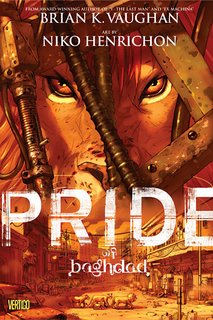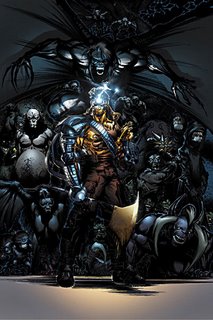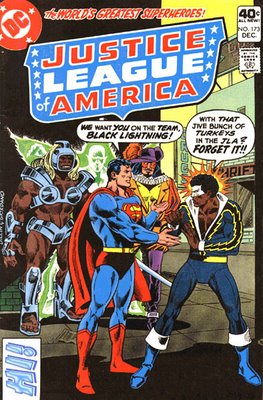 Blue Beetle is a great, fun book. It’s not the most original book in the world — young boy discovers item that gives him great power; somewhere between Power Rangers and Spider-Man — but it’s well executed and has a strong vision. I admit to some trepidation after the past two issues, which suffered from some fair (#5) to poor (#6) art and a bit of a convoluted story. But the book gets back on track with its seventh issue, a standalone story that explains where Jaime’s missing year came from and some background on the scarab and its purpose. And while it’s not terribly surprising to see the book make good on some of its early potential, it is somewhat surprising given the subject of the story: Infinite Crisis.
Blue Beetle is a great, fun book. It’s not the most original book in the world — young boy discovers item that gives him great power; somewhere between Power Rangers and Spider-Man — but it’s well executed and has a strong vision. I admit to some trepidation after the past two issues, which suffered from some fair (#5) to poor (#6) art and a bit of a convoluted story. But the book gets back on track with its seventh issue, a standalone story that explains where Jaime’s missing year came from and some background on the scarab and its purpose. And while it’s not terribly surprising to see the book make good on some of its early potential, it is somewhat surprising given the subject of the story: Infinite Crisis.
To be perfectly honest, I didn’t read Infinite Crisis. But I did read the entirety of The OMAC Project, which is central to Blue Beetle’s role in the story, and found it to be an overwrought, continuity-obsessed, pedantic and predictable mess. Combine that with a general distrust of epic crossovers, and Infinite Crisis was definitely not on the must-read list. So imagine my surprise at thinking it actually seemed kind of cool while reading Blue Beetle. Indeed, when told by the quite able team of John Rogers and Cully Hamner, the idea of a bunch of superheroes going up into space to fight an evil computer and its army of killer robots seems fun.
In the context of the story it’s fairly serious — particularly since it leads to Jaime losing a year of his life — but the story itself has fun with the ideas: Batman gets to be funny and self-deprecating (“Tell them it was Superman. Everybody likes him.”), Green Arrow and Black Canary bicker (“He’s just upset this fight won’t give him a chance to make a speech about poverty.”), and a kid with an alien battle suit of some sort gets to fight robots and save the day. It’s smart and well-executed, and even references continuity here and there, but it doesn’t feel overdone; Rogers is smart enough to understand the superhero genre is built on a lot of silly concepts, and isn’t obsessed with showing off how adult he can be. I’m not sure, but I think he also makes fun of All Star Batman & Robin.
The story and script is good, but I’m particularly happy to see Cully Hamner back on the book after two issues of fill-ins: His style is perfect for the series, light and cartoonish but still maintining an element of realism and drama. He keeps the hero slim and small, eschewing the massive musculature of other superheroes in favour of reminding us that this particular hero is still just a kid. He’s got a clear style for action, and a great sense of character design.
Blue Beetle is a good, fun superhero comic that uses many of the same stories and ideas as the rest of the DCU, but has a much more distinctive and relaxed tone. Sure, it’s about a kid who discovers a mysterious alien artefact that may have been designed to fight Green Lanterns… but it’s about a kid who discovers an alien artefact that gives him incredible powers and may have been designed to figh Green Lanterns. It’s exactly the sort of thing that made superhero comics so popular for so long.
 On the other hand, there’s also Garth Ennis and Darick Robertson’s The Boys, which is also kind of fun and light-hearted, but in the complete opposite direction from Blue Beetle. In traditional Ennis fashion, it’s a realistic approach that yields over-the-top, absurdist results. Mainstream superhero books tend to shy away from Blue Beetle‘s approach in attempting to be “realistic” or “gritty”, but don’t have the guts to take it to the logical extension. Ennis and Robertson give us a world where superheroes are at best self-centred, and at worst utter assholes.
On the other hand, there’s also Garth Ennis and Darick Robertson’s The Boys, which is also kind of fun and light-hearted, but in the complete opposite direction from Blue Beetle. In traditional Ennis fashion, it’s a realistic approach that yields over-the-top, absurdist results. Mainstream superhero books tend to shy away from Blue Beetle‘s approach in attempting to be “realistic” or “gritty”, but don’t have the guts to take it to the logical extension. Ennis and Robertson give us a world where superheroes are at best self-centred, and at worst utter assholes.
It’s not entirely new ground for Ennis, but he’s never hit the subject in quite so much depth before. Many of his ideas are quite sensible – when superheroes and supervillains fight in public, innocent people are going to get hurt and killed. It’s also not unreasonable to suggest that many of the superheroes, being fairly average Joes prior to their radioactive exposures and crime-fighting inventions, might think themselves above the gormless masses. They’re not all assholes, of course, as we find out when the virtuous young Starlight meets with the heroic Homelander and finds her temporary membership in The Seven comes with some unpleasant conditions.
Meanwhile, the loveable bastard Butcher has persuaded Wee Hughie to join him in New York with the rest of The Boys. They establish their headquarters and make plans for their first strike on the superheroes who think they’re so much better than everyone else.
And that’s about it. For the third issue in a row, The Boys continues to set things up and establish characters. And while I certainly enjoy Ennis’ characters and the world he’s creating — I’m particularly intrigued by The Female, who’s some combination of vicious psychopath and innocent young girl — something needs to happen. In the first issue Hughie lost his girlfriend, and Butcher has spent the last two issues convincing him to join his group. Hughie still isn’t convinced. While Ennis all but guarantees action in the next issue, the story is still moving quite slowly; it’d probably be swell in a trade, but it feels slow when read 22 pages at a time.
That said, it’s still Ennis and Robertson having some fun, which makes for an entertaining read. Starlight’s encounter with The Seven is hilarious, disgusting though it may be, as Ennis and Robertson don’t suger-coat anything: It’s all blunt and out in the open. Even if they’re doing a riff on Alan Moore’s superhero porn-ring in Top Ten, they’ve got their own take on it.
One can’t be blamed for feeling some disappointment in The Boys, but much of that has to come with the high expectations that accompany a creative team like this. Ennis and Robertson may be taking their time in setting up the pieces and finding their groove, but they can still produce a readable book. Hopefully the next issue will start the serious and gratuitous ass-kicking.








